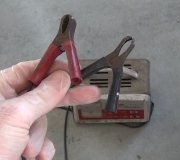The vehicle is listed above is the Ranger model (International Model) with: 3.2L, five cylinder diesel engine; manual trans; 4x4. I suspect I have a bad/deteriorating battery (one or more cells dead?)
>last two to three days was increasingly hard to start.
>would not start yesterday; engine turned off, voltage was 10.6 volts
>jump started and appeared to run okay. Voltage was 14.2 across terminals.
>had to make an emergency medical trip; ran for three hours and did not turn engine off.
>seemed to run okay with AC, electric windows, horn, no engine "hiccups", no panel warning lights.
>returning home, turned off engine and disconnected positive/negative terminals. Voltage was 12.6.
>next morning voltage was 10.6 for disconnected battery.
>original maintenance free battery and monitor shows green (but only for the cell it is in I think).
Question then, with the battery apparently in a poor state, despite "green eye, " can I safely drive the vehicle to a garage three hours away without damaging the vehicle in any way or having it stall out on me?
Thanks in advance.
Tuesday, August 8th, 2017 AT 3:58 PM



